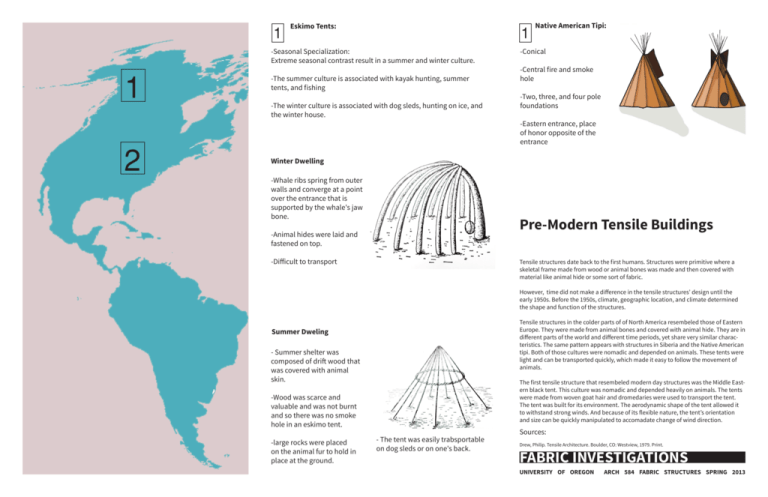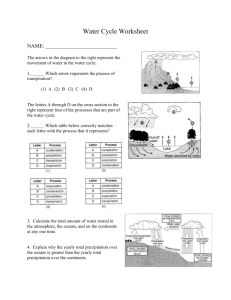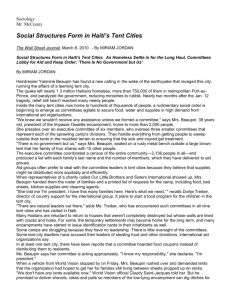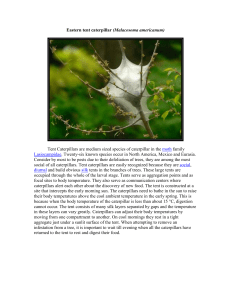HistoryofTensileStructures_Past
advertisement

Eskimo Tents: -Seasonal Specialization: Extreme seasonal contrast result in a summer and winter culture. -The summer culture is associated with kayak hunting, summer tents, and fishing -The winter culture is associated with dog sleds, hunting on ice, and the winter house. Native American Tipi: -Conical -Central fire and smoke hole -Two, three, and four pole foundations -Eastern entrance, place of honor opposite of the entrance Winter Dwelling -Whale ribs spring from outer walls and converge at a point over the entrance that is supported by the whale's jaw bone. Pre-Modern Tensile Buildings -Animal hides were laid and fastened on top. -Difficult to transport Tensile structures date back to the first humans. Structures were primitive where a skeletal frame made from wood or animal bones was made and then covered with material like animal hide or some sort of fabric. However, time did not make a difference in the tensile structures’ design until the early 1950s. Before the 1950s, climate, geographic location, and climate determined the shape and function of the structures. Tensile structures in the colder parts of of North America resembeled those of Eastern Europe. They were made from animal bones and covered with animal hide. They are in different parts of the world and different time periods, yet share very similar characteristics. The same pattern appears with structures in Siberia and the Native American tipi. Both of those cultures were nomadic and depended on animals. These tents were light and can be transported quickly, which made it easy to follow the movement of animals. Summer Dweling - Summer shelter was composed of drift wood that was covered with animal skin. The first tensile structure that resembeled modern day structures was the Middle Eastern black tent. This culture was nomadic and depended heavily on animals. The tents were made from woven goat hair and dromedaries were used to transport the tent. The tent was built for its environment. The aerodynamic shape of the tent allowed it to withstand strong winds. And because of its flexible nature, the tent’s orientation and size can be quickly manipulated to accomadate change of wind direction. -Wood was scarce and valuable and was not burnt and so there was no smoke hole in an eskimo tent. -large rocks were placed on the animal fur to hold in place at the ground. - The tent was easily trabsportable on dog sleds or on one's back. Sources: Drew, Philip. Tensile Architecture. Boulder, CO: Westview, 1979. Print. FABRIC INVESTIGATIONS UNIVERSITY OF OREGON ARCH 584 FABRIC STRUCTURES SPRING 2013 3 5 Yakut Urasa Tent: Kibita Tent: -Prefabricated, demountable and transportable. -Consists of external envelope of felt or reed. supported by a sturdy frame of wood. 4 3 -Conical and domical structure -Made from mammoth bones and animal hide -Erected in the summer 6 5 -Used in the ice age by hunters -Was not transportable 4 Middle Eastern Black Tent: 6 Siberian Tents: - Prestressed velum is tensed in an aerodynamic shape over wood supports and is able to withstand strong winds. -Conical, cylindrical, and polygonal structures. -Closest form to 20th century prestressed tensile architecture. -Flexible construction, animal dependent -Summer dwellings used by nomadic herders or hunters Features of a siberian tent -Its stability and resistance to wind depends heavily on its orientation and aerodynamic shape, long slanting anchor ropes, and the geometry of the tent. -Made from woven goat or camel hair and velum. It is woven loosely to allow air to permeate the walls. When it rains, the fabric shrinks and thickens, preventing water to go through. -Conical framework of inclined poles, arranged in a circle with their upper ends secured at the peak. -T-struts brace brace roof poles at mid span and the walls, which are supported by tripod supports or a inverted V-strut framing. -Foundation of the cylindrical tent is similar to the conical tent. Eskimo Tents: -Seasonal Specialization: Extreme seasonal contrast result in a summer and winter culture. -The summer culture is associated with kayak hunting, summer tents, and fishing -The winter culture is associated with dog sleds, hunting on ice, and the winter house. Native American Tipi: -Conical -Central fire and smoke hole -Two, three, and four pole foundations -Eastern entrance, place of honor opposite of the entrance Winter Dwelling -Whale ribs spring from outer walls and converge at a point over the entrance that is supported by the whale's jaw bone. Pre-Modern Tensile Buildings -Animal hides were laid and fastened on top. -Difficult to transport Tensile structures date back to the first humans. Structures were primitive where a skeletal frame made from wood or animal bones was made and then covered with material like animal hide or some sort of fabric. However, time did not make a difference in the tensile structures’ design until the early 1950s. Before the 1950s, climate, geographic location, and climate determined the shape and function of the structures. Tensile structures in the colder parts of of North America resembeled those of Eastern Europe. They were made from animal bones and covered with animal hide. They are in different parts of the world and different time periods, yet share very similar characteristics. The same pattern appears with structures in Siberia and the Native American tipi. Both of those cultures were nomadic and depended on animals. These tents were light and can be transported quickly, which made it easy to follow the movement of animals. Summer Dweling - Summer shelter was composed of drift wood that was covered with animal skin. The first tensile structure that resembeled modern day structures was the Middle Eastern black tent. This culture was nomadic and depended heavily on animals. The tents were made from woven goat hair and dromedaries were used to transport the tent. The tent was built for its environment. The aerodynamic shape of the tent allowed it to withstand strong winds. And because of its flexible nature, the tent’s orientation and size can be quickly manipulated to accomadate change of wind direction. -Wood was scarce and valuable and was not burnt and so there was no smoke hole in an eskimo tent. -large rocks were placed on the animal fur to hold in place at the ground. - The tent was easily trabsportable on dog sleds or on one's back. Sources: Drew, Philip. Tensile Architecture. Boulder, CO: Westview, 1979. Print. FABRIC INVESTIGATIONS UNIVERSITY OF OREGON ARCH 584 FABRIC STRUCTURES SPRING 2013


